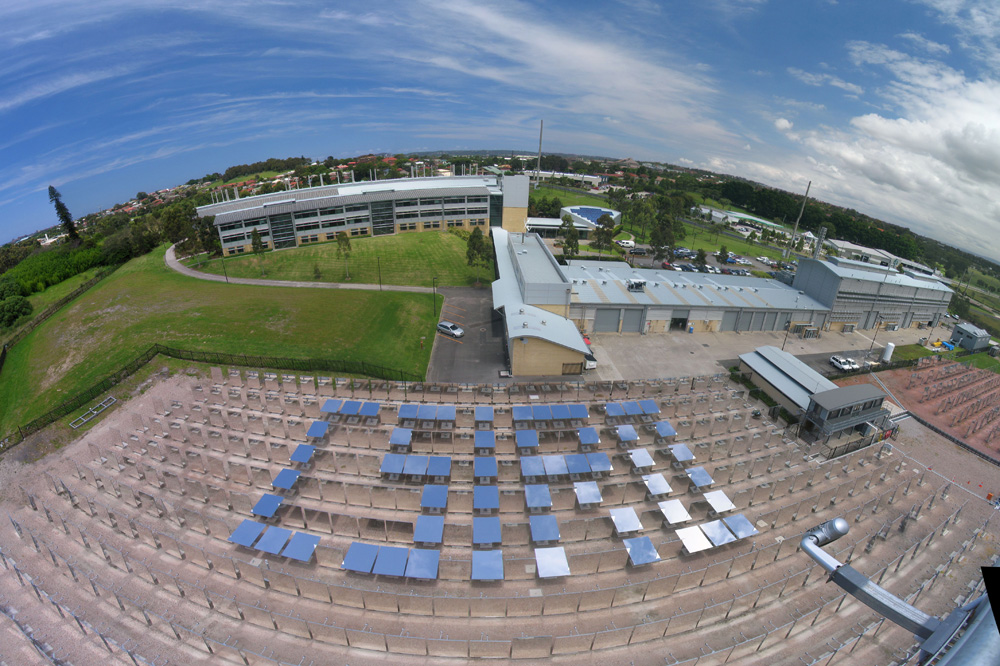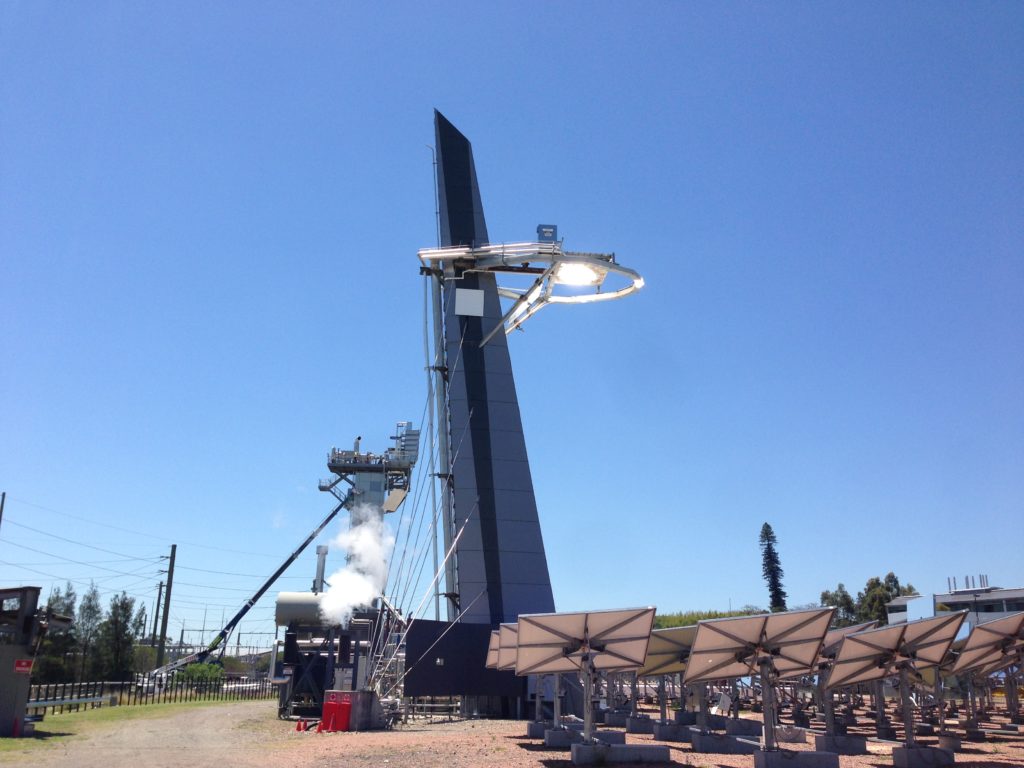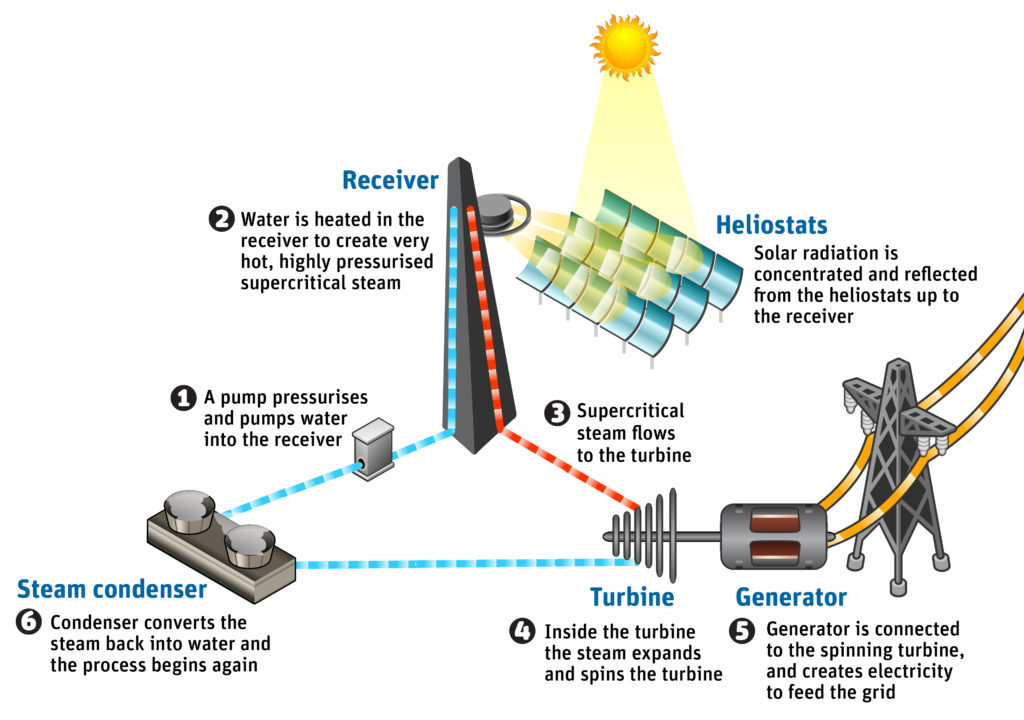
A picture of heliostats.
The Energy Centre heliostat array, taken from Tower 2.
The run of sunny weather we’ve had in south-eastern Australia over the last few weeks has been breaking quite a few records – and not just on the weather charts.
A team of solar thermal engineers and scientists at our Energy Centre in Newcastle have used the ample sunlight flooding their solar fields to create what’s called ‘supercritical’ steam – an ultra-hot, ultra-pressurised steam that’s used to drive the world’s most advanced power plant turbines – at the highest levels of temperature and pressure EVER recorded with solar power.
They used heat from the sun, reflected off a field of heliostats (or mirrors) and concentrated onto a central receiver point to create the steam at these supercritical levels. The achievement is being described in the same terms as breaking the sound barrier, so impressive are its possible implications for solar thermal technology.
So what is it exactly that these Chuck Yaegers of the solar world have gone and done?
A graphic showing a solar thermal power plant works.
How a supercritical solar thermal power plant would work.
Put simply, the temperature of the steam they created (570° C) is about twice the maximum heat of your kitchen oven – or around the point where aluminium alloy would start melting. And the accompanying pressure (23.5 megapascals) is about 100 times as high as the pressure in your car tyres, or roughly what you’d experience if you were about 2 kilometres under the surface of the ocean.
That’s all impressive in itself. But when you take into consideration that this is the first time solar power has ever been used to create these ‘supercritical’ levels on this scale – traditionally only ever reached using the burning of fossil fuels – the real worth of this achievement begins to sink in.
Solar thermal, or concentrating solar power (CSP) power plants have traditionally only ever operated at ‘subcritical’ levels, meaning they could not match the efficiency or output of the world’s most state of the art fossil fuel power plants.

A picture of a solar thermal tower.
The solar thermal tower in action: check out the steam being generated.
Enter our team and their Advanced Solar Steam Receiver Project. To prove that solar thermal technology can match it with the best fossil fuel systems, they developed a fully automated control system which predicts the heat delivered from every mirror (or heliostat), allowing them to achieve maximum heat transfer, without overheating and fatiguing the receiver. With this amount of control, they were able to accurately recreate the temperature and pressures needed for supercritical success.
So instead of relying on burning coal to produce supercritical steam, this method demonstrates that the power plants of the future could be using the zero emission energy of the sun to reach peak efficiency levels – and at a cheaper price.
While the technology may be a fair way off commercial development, this achievement is a big step in paving the way for a low cost, low emission energy future.
The $5.68 million research program is supported by the Australian Renewable Energy Agency and is part of a broader collaboration with Abengoa Solar, the largest supplier of solar thermal electricity in the world.
For media inquiries, contact Simon Hunter – Phone: +61 3 9545 8412 Email: simon.hunter<at>csiro.au



6th June 2014 at 11:04 pm
How about this combination of technology making use of technically simpler challenge than super-critical steam. (… The reason is that a substantial number of coal-fired plants are planned for construction and a financially superior technology is the most irrefutable argument against these projects commencing.)
1. GreatPoint Energy has a catalytic methanation process that users steam to convert carbon-rich feedstocks – such as coal, petcoke, and biomass into a methane-rich gas stream from which CO2 is readily separated.
2. Algae.Tec has a process for growing algae from concentrated sunlight and CO2. The algae is most profitable in nutrient supplements, but can also produce edible oil to replace palm oil. Algae may also be used for stock feed.
The production of methane from coal allows electricity to be generated in combined heat and power distributed units and in CCGT power plants with efficiencies over 60 percent. This is far better than the most advanced supercritical coal-fired plant which can only achieve about 45 percent efficiency.
The embedding of solar thermal energy in the methane produced from coal or biomass with GreatPoint Energy’s technology avoids the cost of thermal energy storage.
Combining CSIRO’s solar thermal technology with these other two proven technologies – GreatPoint Energy and Algae.Tec’s – provides a faster and technically simpler path to commercial realisation and avoiding construction of more coal-fired plants.
6th June 2014 at 4:08 pm
Can this technology also take in the “salt rock” experiments being done by Gemasolar power plant in Seville, Spain to heat steam for night time use? The radiation heats molten salts that circulate inside the tower to temperatures of more than 500 °C (932 °F). The hot molten salts are then stored in tanks that are specially designed to maintain the high temperatures. This cutting-edge heat storage system enables the power plant to run steam turbines and generate electricity for up to 15 hours without any incoming solar radiation. Obviously incorporating both systems into one technology would be awsome and I believe really assist this great new breaking technology that you have created.
Read more at: http://phys.org/news/2011-07-gemasolar-solar-thermal-power-hours.html#nRlv
5th June 2014 at 9:37 pm
How much steam was produced??? (Volume: Lbs/hour?)
My guess is, very little, or else this would be commercially viable now…
They always seem to leave the pertinent information out when it isn’t positive.
6th June 2014 at 11:24 am
Hi automaticsteam, thanks for your comment. Here’s a response from project lead, Robbie McNaughton:
“Steam flowed at around 330kg/hr , which equates to a little over 300kW of adsorbed solar energy. The experiments were designed to represent a single element of large scale design, so scale up is related more to multiplicity than redefining heat and mass fluxes.”
17th June 2014 at 9:44 pm
Thank you Nicholas so much for the response.
My 1000 sq ft home has 10, 1.5kW/hr electric resistance heaters (baseboard); 15kW/hr total. In moderately freezing temperatures; around 20F / -6.66C, my heat will run about 1/3 of the hour; 20 minutes, or expend 5kW.
Roughly, 300kW is about enough energy to heat 60 such homes here.
The project output at 330kg/hr equates to about 666lbs/hr@34.5lbs/hr equalling roughly 20hp – the size of a steam boiler used in a large corner dry cleaning plant.
I think the project has proven that the technology is abjectly inviable. That in itself is very valuable information. Time to move on.
No multiplicity of cells, as we understand energy/steam generation today will ever move or improve the economy of scale more than about one iota. The laws of physics say so.
I think tapping into magma is far more viable, and good fortune has it, right now the Earth’s core is heating up, and magma is coming closer to the surface.
I would like for the team to help me develop the quantum frostless heat pump (US patent 7,895,850) which we can make commercial within 2 years, and save 10% over current heat pump technology, simply, cheaply, easily.
Heat pump; geothermal, water to air, and air to air, are the future for now for practical electric heat.
As to the steam temperatures and pressures the project developed, lauching jets off an aircraft carrier would be a great application, but the required boiler horsepower to launch a jet would be about 50 times greater than the project produced.
Am I missing something here?
5th June 2014 at 4:00 pm
Well done champs. Proud of my CSIRO. Pity the government is cutting the funding source for this, the Australian Renewable Energy Agency.
A question … how much more efficient is this than generating electricity directly through photovoltaic cells?
Also, is the entire system energy positive and self-contained? e.g. where does the power come from to pump the water up the tower? Does this come from within the steam produced energy itself?
10th June 2014 at 1:15 pm
Hi Carl
Robbie McNaughton, our project lead, has addressed your questions:
“It is difficult to give a straight comparison between solar thermal and PV as they have unique strengths, weakness, costs and daily/annual capacities. The peak efficiency is only one parameter.
Yes, the system is energy positive and self contained. The water pump is powered by the system itself and only consumes a small fraction of the net power.”
Cheers
Nick
5th June 2014 at 11:41 am
Old news! This technique – already used world-wide and not invented by CSIRO – has been welcomed in South Australia to replace the old coal power plant at Port Augusta. Please see: http://repowerportaugusta.org/ and http://media.bze.org.au/Repowering_PortAugusta.pdf .
But, of course, this is South Australia (where CSIRO first began, incidentally) so it does not make news…
5th June 2014 at 2:35 pm
Hi there
I will hand over again to Mike Collins, one of our scientists working on the project:
“Yes, older solar thermal power station designs could have powered old turbines like the one used at the Alinta plant in Port Augusta.
However, the results achieved by the CSIRO team could see not just these “sub-critical” turbines powered by the sun, but even state of the art plants with the world’s most advanced supercritical steam turbines.”